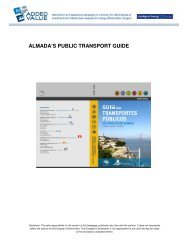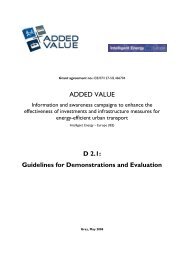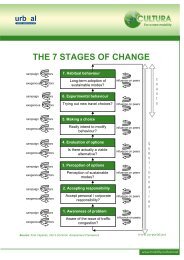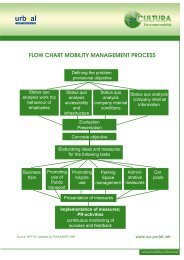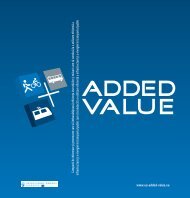SUMO - Eltis
SUMO - Eltis
SUMO - Eltis
You also want an ePaper? Increase the reach of your titles
YUMPU automatically turns print PDFs into web optimized ePapers that Google loves.
E – Acceptance of the offer<br />
The percentage of people who express willingness to accept the offer, i.e. said they are<br />
willing to test the offer (new travel option, receiving a cycle helmet, etc.), is a measure<br />
of acceptance of the offer. However, this does not mean that these persons actually test<br />
and use the offer. In a company or organisation acceptance can been expressed as a percentage<br />
of employees that accept management decisions governing travel choices at the<br />
company.<br />
Method<br />
Registering the number of people that contact a suggested carpooling group or who<br />
receive a cycle helmet with the intention of using it is a measure of acceptance for the<br />
offer. Note that acceptance of an offered service does not necessarily mean that people<br />
actually change their behaviour or even try the offer.<br />
Examples of indicators and collection methods for acceptance in the Test Traveller<br />
project are presented below.<br />
INDICATOR METHOD<br />
The number of people that after receiving information about<br />
requirements are interested in becoming a test traveller. Can<br />
be stated as a percentage of the employees who are interested.<br />
Interviews / questionnaire<br />
surveys<br />
F – Experimental individual behaviour<br />
Many projects are run during a specific time, such as a campaign month. During this<br />
time, individuals are encouraged to test new behaviour, something that can be called<br />
experimental behavioural change. The temporary behavioural changes measured here<br />
should not be confused with permanent behavioural changes.<br />
Method<br />
To be able to assess the impact a measure has on individual behaviour one must have a<br />
measure of behaviour before the project is implemented. Behavioural changes for each<br />
project participant, or a selection of persons, are measured and compared before and<br />
during the project. These initial levels could have been identified earlier, perhaps as participants<br />
were chosen for the project, but if necessary these can be identified retrospectively<br />
with questions to people about what they used to do before the project started.<br />
Examples of indicators and collection methods for experimental individual behaviour<br />
in the Test Traveller project are presented below.<br />
INDICATOR METHOD<br />
Percentage of public transport days per week during the<br />
test period.<br />
Interviews / questionnaire<br />
surveys<br />
Distance travelled. Interviews / questionnaire<br />
surveys<br />
Number of people that travel by public transport at least 3<br />
days per week during the test period. This could be expressed<br />
as a percentage of employees.<br />
Interviews / questionnaire<br />
surveys<br />
sumo – System for Evaluation of Mobility Projects 29<br />
INDICATORS AND METHODS



